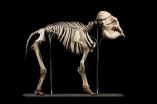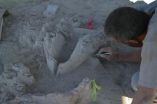(Press-News.org) New research from The University of Texas MD Anderson Cancer Center is shedding light on the important role a diagnosing urologist plays in whether older men with low-risk prostate cancer receive treatment for their disease, and if so, the type of treatment they receive as a result.
The findings, published in JAMA Internal Medicine, sought to examine why active surveillance, a management program for low-risk disease, which includes repeat PSAs, prostate exams and biopsies, is underused in this patient population.
According to the American Cancer Society, 233,000 new cases of prostate cancer will be diagnosed this year, making it the most common non-skin cancer in men. Previous studies have shown mortality rates are similar for those who opt for surveillance versus treatment in this older population, yet many men continue to incur unnecessary treatment harms.
"What's striking was just how much variation exists in managing prostate cancer, with the diagnosing physician playing as much a role, if not more of a role, than accepted patient factors that impact surveillance use," said Karen Hoffman, M.D., assistant professor in Radiation Oncology and lead author.
Using the Surveillance, Epidemiology and End Results (SEER) registry, researchers identified 12,068 men ages 66 and older diagnosed with low-risk prostate cancer from 2006—2009. Physician characteristics were obtained from linked Medicare claims to determine variations attributable to medical degree, year of training, training location and board certifications.
The main outcome was no cancer-directed therapy within 12 months of diagnosis. Researchers also set to determine the impact of the diagnosing urologist on treatment decisions, quantify the rate of surveillance versus treatment and identify urologist and patient factors associated with surveillance selection.
Results Indicate Widespread Differences
Of the 12,068 men, 80 percent received treatment and only 20 percent underwent observation. Observation rates varied significantly across urologists, from 4.5 to 64.2 percent, and radiation oncologists, from 2 to 47 percent.
Interestingly, researchers found the diagnosing urologist accounted for more than double the rate of variation seen in treatment versus observation decisions compared to individual patient characteristics such as age, comorbidities and PSA level.
Patients diagnosed by urologists who treated low-risk prostate cancer were more likely to receive treatment, and when treated, more likely to receive a therapy their diagnosing urologist used. Hoffman said these findings suggest that physicians not only influence decision making, but the type of treatment selected.
For example, the research found that patients diagnosed by urologists who billed for external beam radiation therapy were more likely to receive it, bringing financial considerations into the fold. The study could not determine those physicians with ownership interests in radiation equipment, but the finding that was also referenced in earlier reports underscores a possible rationale behind some of the disparity.
The authors note public reporting of physician's cancer management profiles would enable primary care providers and patients to make more informed decisions when selecting a physician to diagnose and treat their prostate cancer.
"Primary care physicians play a key role because they refer patients to urologists for elevated PSA levels and prostate biopsies. Increasing transparency could lead to selecting physicians more open to surveillance," Hoffman said.
The authors note several limitations to the study. Those included shifting practice patterns that may influence treatment decisions and the inability to measure certain factors that may impact treatment choice, such as family history and patient anxiety.
Follow-up work in this area will evaluate if patient counseling in a multidisciplinary setting and patient decision aids increase active surveillance acceptance.
INFORMATION:
This work was supported by grants from the Cancer Prevention and Research Institute of Texas (RP101207), the National Cancer Institute (T32CA77050, CA079466), the American Cancer Society (RSGI-09-149-01-CPHPS), the McCombs Institute, Center for Radiation Oncology Research at MD Anderson and the National Cancer Institute (P30CA016672).
In addition to Hoffman, other authors on the all MD Anderson study include: Benjamin Smith, M.D., Grace Smith, M.D., Ph.D., Thomas Buchholz, M.D., George Perkins, M.D., Deborah Kuban, M.D. of Radiation Oncology; Sharon Giordano, M.D. and Jiangong Niu, Ph.D. of Health Services Research; Yu Shen, Ph.D. and Jing Jiang of Biostatistics; John Davis, M.D. and Jay Shah, M.D. of Urology; Jeri Kim, M.D. of Genitourinary Medical Oncology; and Robert Volk, Ph.D., General Internal Medicine.
Disclosures: Hoffman receives research support from the American Society for Radiation Oncology and Benjamin Smith receives funding from Varian Medical Systems.
Study finds diagnosing physicians influence therapy decisions for prostate cancer patients
Wide variations seen in up-front therapy versus active surveillance
2014-07-14
ELSE PRESS RELEASES FROM THIS DATE:
The power of making amends
2014-07-14
CORAL GABLES, Fla. -- It's well known that when a person takes steps to make amends for a wrongdoing, the victim is more inclined to forgive and forget. However, exactly why that happens is less obvious and poorly understood. In a recent study, scientists made substantial progress in explaining the psychological processes that make forgiveness happen.
Their findings show that peacemaking efforts such as apologies, offers of compensation and owning up to one's responsibility increase forgiveness—and reduce anger—by making the aggressor seem more valuable as a relationship ...
New research suggests soluble corn fibre may boost calcium absorption
2014-07-14
Hoffman Estates, IL – Around the globe, fibre and calcium intakes are below the levels recommended by experts1,2,3 contributing to potential long-term public health implications1,3,4. New research, published this month in the British Journal of Nutrition, shows soluble corn fibre (SCF) may not simply boost fibre intake when added to foods, but can also increase the amount of beneficial bacteria present in the gut, while enhancing calcium absorption in adolescents5. SCF is a prebiotic fibre that is well tolerated, and is easily incorporated into foods or beverages to boost ...
Research: Business should embrace 'boomerang employees'
2014-07-14
CHAMPAIGN, Ill. — The return of LeBron James to the Cleveland Cavaliers may have riveted the sports world and social media, but the phenomenon of "going home," whether to a geographic location or a former job, is not unique to professional athletes.
According to two studies co-written by a University of Illinois expert in organizational behavior and human resources management, organizations of all types are beginning to recognize and embrace the value of recruiting and welcoming back former employees.
From infantry soldiers to chief executives, accountants and professional ...
Months before their first words, babies' brains rehearse speech mechanics
2014-07-14
Infants can tell the difference between sounds of all languages until about 8 months of age when their brains start to focus only on the sounds they hear around them. It's been unclear how this transition occurs, but social interactions and caregivers' use of exaggerated "parentese" style of speech seem to help.
University of Washington research in 7- and 11-month-old infants shows that speech sounds stimulate areas of the brain that coordinate and plan motor movements for speech.
The study, published July 14 in the Proceedings of the National Academy of Sciences, ...
Moderate alcohol use associated with increased risk for atrial fibrillation
2014-07-14
Even in moderation, consumption of wine and hard liquor may be a risk factor for atrial fibrillation, an abnormally fast heartbeat that can lead to stroke, heart failure and dementia, according to new research published today in the Journal of the American College of Cardiology. The research did not identify a similar risk for moderate consumption of beer.
Researchers in Sweden studied 79,016 adults, ages 45 to 83, who completed an extensive questionnaire about food and alcohol consumption in 1997. The researchers followed the participants for up to 12 years through ...
Genome-wide analysis reveals genetic similarities among friends
2014-07-14
If you consider your friends family, you may be on to something. A study from the University of California, San Diego, and Yale University finds that friends who are not biologically related still resemble each other genetically.
Published in the Proceedings of the National Academy of Sciences, the study is coauthored by James Fowler, professor of medical genetics and political science at UC San Diego, and Nicholas Christakis, professor of sociology, evolutionary biology, and medicine at Yale.
"Looking across the whole genome," Fowler said, "we find that, on average, ...
Running for life: How speed restricts evolutionary change of the vertebral column
2014-07-14
One of the riddles of mammal evolution explained: the strong conservation of the number of trunk vertebrae. Researchers of the Naturalis Biodiversity Center and the University of Utah show that this conservation is probably due to the essential role of speed and agility in survival of fast running mammals. They measured variation in vertebrae of 774 individual mammal skeletons of both fast and slow running species. The researchers found that a combination of developmental and biomechanical problems prevents evolutionary change in the number of trunk vertebrae in fast ...
Meet the gomphothere: UA archaeologist involved in discovery of bones of elephant ancestor
2014-07-14
An animal once believed to have disappeared from North America before humans ever arrived there might actually have roamed the continent longer than previously thought – and it was likely on the list of prey for some of continent's earliest humans, researchers from the University of Arizona and elsewhere have found.
Archaeologists have discovered artifacts of the prehistoric Clovis culture mingled with the bones of two gomphotheres – an ancient ancestor of the elephant – at an archaeological site in northwestern Mexico.
The discovery suggests that the Clovis – the ...
Acute glaucoma discovered to be an inflammatory disease
2014-07-14
Researchers at the University of California, San Diego School of Medicine and Sun Yat-sen University in China have shown that acute glaucoma in mice is largely an inflammatory disease and that high pressure in the eye causes vision loss by setting in motion an inflammatory response similar to that evoked by bacterial infections.
The study, published in this week's issue of the Proceedings of the National Academy of Sciences, has immediate clinical relevance in treating the tens of millions of people worldwide from what is known as acute closed-angle glaucoma.
"Our research ...
CRISPR system can promote antibiotic resistance
2014-07-14
CRISPR, a system of genes that bacteria use to fend off viruses, is involved in promoting antibiotic resistance in Francisella novicida, a close relative of the bacterium that causes tularemia. The finding contrasts with previous observations in other bacteria that the CRISPR system hinders the spread of antibiotic resistance genes.
The results are scheduled for publication in PNAS Early Edition.
The CRISPR system has attracted considerable attention for its potential uses in genetic engineering and biotechnology, but its roles in bacterial gene regulation are still ...
LAST 30 PRESS RELEASES:
Making lighter work of calculating fluid and heat flow
Normalizing blood sugar can halve heart attack risk
Lowering blood sugar cuts heart attack risk in people with prediabetes
Study links genetic variants to risk of blinding eye disease in premature infants
Non-opioid ‘pain sponge’ therapy halts cartilage degeneration and relieves chronic pain
AI can pick up cultural values by mimicking how kids learn
China’s ecological redlines offer fast track to 30 x 30 global conservation goal
Invisible indoor threats: emerging household contaminants and their growing risks to human health
Adding antibody treatment to chemo boosts outcomes for children with rare cancer
Germline pathogenic variants among women without a history of breast cancer
Tanning beds triple melanoma risk, potentially causing broad DNA damage
Unique bond identified as key to viral infection speed
Indoor tanning makes youthful skin much older on a genetic level
Mouse model sheds new light on the causes and potential solutions to human GI problems linked to muscular dystrophy
The Journal of Nuclear Medicine ahead-of-print tip sheet: December 12, 2025
Smarter tools for peering into the microscopic world
Applications open for funding to conduct research in the Kinsey Institute archives
Global measure underestimates the severity of food insecurity
Child survivors of critical illness are missing out on timely follow up care
Risk-based vs annual breast cancer screening / the WISDOM randomized clinical trial
University of Toronto launches Electric Vehicle Innovation Ontario to accelerate advanced EV technologies and build Canada’s innovation advantage
Early relapse predicts poor outcomes in aggressive blood cancer
American College of Lifestyle Medicine applauds two CMS models aligned with lifestyle medicine practice and reimbursement
Clinical trial finds cannabis use not a barrier to quitting nicotine vaping
Supplemental nutrition assistance program policies and food insecurity
Switching immune cells to “night mode” could limit damage after a heart attack, study suggests
URI-based Global RIghts Project report spotlights continued troubling trends in worldwide inhumane treatment
Neutrophils are less aggressive at night, explaining why nighttime heart attacks cause less damage than daytime events
Menopausal hormone therapy may not pose breast cancer risk for women with BRCA mutations
Mobile health tool may improve quality of life for adolescent and young adult breast cancer survivors
[Press-News.org] Study finds diagnosing physicians influence therapy decisions for prostate cancer patientsWide variations seen in up-front therapy versus active surveillance




